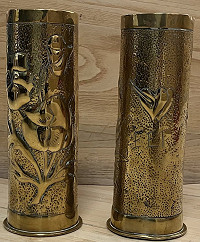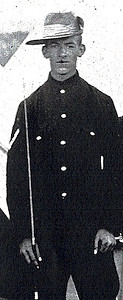Trench Shells

German Shell Cases manufactured in 1917

Rawlings c1908 in the Territorial Force
In Louth Museum two examples of beautifully decorated First World War trench art caught my eye. They were a pair of brass artillery shell cases which a Louth man had brought home from the Western Front. At some point he engraved them and turned them into souvenirs of the war.
Researching the two shells led to the discovery that they were both manufactured in Düsseldorf in 1917. This was a time when strikes due to food rationing and starvation, were rampant in the German munitions factories. Markings on the underside of each shell provided the month and year of each’s manufacture as well as additional information about where they originally came from. One was created in the Haniel Luege brass factory in January 1917, and the other was made in the Rheinische Metallwaren-Fabrik in April of the same year.
Both shells feature a poppy design, which became a well-known symbol of remembrance in the later years of the First World War due to the red poppies that grew on No Man’s Land after bloody conflicts. One of the shells also features an unusual double heart design pierced by an arrow. Below, intriguingly, are the initials of the engraver- E.E.R.. This led to the second part of my research – who was E.E.R.?
Further digging revealed that Ernest Edward Rawlings was born in Louth and lived on Commercial Road for most of his life. He volunteered for the Territorial Force in 1908 at the age of 28. He went on to serve in the North Midland Brigade in the Royal Field Artillery during the First World War. He had worked as a house painter prior to the war and later became a coach painter and signwriter, which would have provided him with many of the skills necessary for engraving the shells. He married a local teacher, Albina Melinda Dixon, who was originally from Horncastle. They had three children, two daughters and a son. Post-war, Rawlings became a part time firefighter and often carried the mace in mayoral parades through the town. This latter fact was mentioned in his obituary, which featured in the local paper when he died in 1965 at the age of 84.
I greatly enjoyed researching the journey of these shells from their origins in the Rhineland to their use on the Western Front, their subsequent engraving and embossment by Ernest Rawlings, and their eventual placement on display as trench art in Louth Museum. Despite all I have discovered about the shells, however, I am left with a question as to whether there was any deeper personal significance to Rawlings’ design choice of a double heart and arrow.